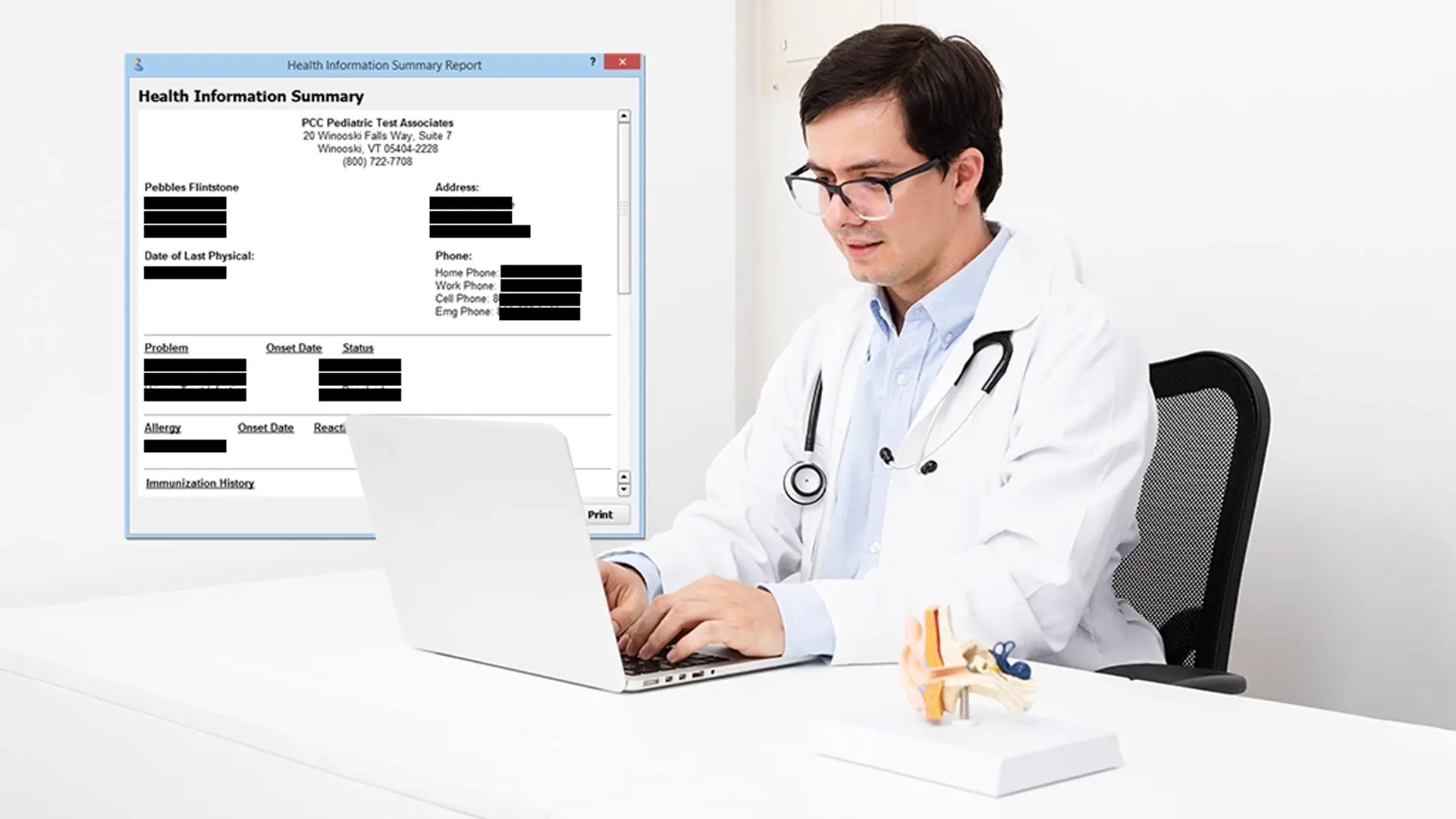What Healthcare Teams Should Know About PHI Redaction
by Moazzam Iqbal, Last updated: November 19, 2025

Discover how healthcare redaction software automates the protection of sensitive patient data. This blog explores how it simplifies PHI redaction, ensures HIPAA compliance, and strengthens data security for healthcare organizations.
Let’s walk in the shoes of a healthcare IT professional. They’ve fortified their network with the latest cybersecurity protocols, conducted rigorous staff training, and ensured compliance with HIPAA guidelines. But despite all this effort, one overlooked piece of unredacted Protected Health Information (PHI) in a document or video can unravel everything. The consequences? Costly fines, legal liabilities, and a potential loss of patient trust that could take years to rebuild.
In 2023 alone, healthcare data breaches exposed the sensitive information of over 88 million patients, according to the U.S. Department of Health and Human Services. Notable breaches included incidents at HCA Healthcare, Community Health Systems, and PharMerica, highlighting how even large, well-resourced organizations are vulnerable to improperly handled PHI.
This goes beyond compliance—a significant business risk that can severely impact even the most resilient organizations.
That’s where Healthcare Redaction Software comes in. This advanced software automates the tedious, error-prone PHI redaction process, ensuring data security and regulatory compliance. This blog will explore how healthcare redaction software protects sensitive patient data, simplifies workflows, reduces operational costs, and enhances compliance efforts.
The Growing Threat to Patient Data and the Need for Healthcare Redaction Software
In today’s rapidly evolving digital healthcare environment, safeguarding patient data has never been more critical. With the increasing reliance on electronic health records and digital communication tools, healthcare organizations face unprecedented challenges in ensuring the confidentiality and security of Protected Health Information (PHI). Understanding these challenges is the first step toward implementing robust data protection measures.
What is PHI, and Why Is It Critical to Protect?
Protected Health Information (PHI) refers to any data that can identify a patient, including names, addresses, medical record numbers, and even biometric data. With the digitization of healthcare, PHI is now stored and transmitted across multiple platforms, increasing the risk of unauthorized access.
Regulations like HIPAA (Health Insurance Portability and Accountability Act) and GDPR (General Data Protection Regulation) mandate strict protocols for PHI protection. Non-compliance can result in severe fines, legal repercussions, and reputational damage.
Common Threats to PHI:
Due to its sensitive nature and high value on the black market, Protected Health Information (PHI) is a prime target for various security threats. Understanding these threats is crucial for implementing effective data protection strategies.
Cybersecurity Breaches
Hacking incidents and ransomware attacks specifically target healthcare systems due to the high value of PHI. For instance, in 2023, HCA Healthcare, one of the largest healthcare providers in the U.S., experienced a breach that compromised the personal data of over 11 million patients.
Similarly, Community Health Systems suffered a ransomware attack that exposed sensitive patient data, while PharMerica, a leading pharmacy services provider, faced a breach affecting almost 6 million individuals. These incidents highlight the increasing sophistication and frequency of cyberattacks on healthcare organizations.
Insider Threats
Employees unintentionally or maliciously expose sensitive data. A notable case occurred at Massachusetts General Hospital, where an employee’s unauthorized access to patient records led to significant legal and financial repercussions. Such internal risks underscore the need for stringent access controls and regular staff training.
Accidental Data Exposure
Human error in handling or sharing patient data. For example, UW Medicine accidentally exposed the medical data of nearly 1 million patients online due to a misconfigured server. This incident illustrates how simple mistakes can lead to large-scale data breaches.
Consequences of Poor PHI Protection:
Failing to properly protect Protected Health Information (PHI) can have far-reaching impacts on healthcare organizations, not just financially but also legally and reputationally.
Legal Penalties
HIPAA violations can cost up to $1.5 million annually per violation type. For instance, Anthem Inc. faced a record $16 million fine in 2018 following a cyberattack that exposed the data of nearly 79 million individuals. The fine underscored the importance of robust cybersecurity measures and compliance protocols.
Financial Costs
Cottage Health faced a $3 million penalty for exposing patient records due to a lack of proper security controls. The breach occurred when patient records were inadvertently made accessible online without adequate password protection or encryption, exposing sensitive information such as medical histories, diagnoses, and personal details.
This incident highlighted significant lapses in data security protocols. It served as a costly reminder of the financial consequences healthcare organizations can face when failing to implement robust data protection measures.
Reputational Damage
A redaction error can erode years of patient trust and damage an institution’s credibility. For example, imagine an extensive hospital network unintentionally sharing patient discharge summaries with incomplete manual redaction. Sensitive details such as patient names, medical conditions, and treatment histories were left partially visible in documents sent to third-party vendors.
This oversight led to public concern, regulatory scrutiny, and a significant decline in patient trust. The incident highlighted the critical need for reliable, automated redaction processes in healthcare to prevent such damaging errors.
Why Manual Redaction is Ineffective Compared to Advanced Healthcare Redaction Software
While understanding the risks associated with PHI breaches is crucial, it’s equally important to recognize why traditional redaction methods are insufficient. Many healthcare organizations still rely on manual processes to redact sensitive information, believing this hands-on approach ensures accuracy.
However, given increasing data volumes and evolving regulatory landscapes, manual redaction introduces more challenges than it solves.
The Complexity of Manual Redaction
Redacting sensitive information manually from medical documents, videos, and audio files is incredibly time-consuming and labor-intensive. It requires meticulous attention to detail to identify and obscure PHI without compromising the document's integrity. Despite best efforts, human error is inevitable. A missed identifier—like a patient’s name, social security number, or medical record number—can result in serious compliance violations, legal liabilities, and potential data breaches. The manual process is inefficient and unreliable, especially with complex documents containing multiple data points across various formats.
Scalability Issues
Healthcare institutions process data daily, from electronic health records (EHRs) and diagnostic reports to telemedicine video consultations and insurance documents. The volume is simply too large to manage manually. As patient data grows exponentially, manual redaction processes become bottlenecks, causing delays in data sharing and disrupting workflows.
For example, hospitals with thousands of patient files may face significant backlogs if relying solely on manual redaction methods. This inefficiency hampers the ability to provide timely care, delays research efforts, and increases operational costs.
Regulatory Compliance Risks
Regulations like HIPAA and GDPR are continuously evolving, with new requirements emerging to address the changing data privacy landscape. Manual redaction methods struggle to keep pace with these updates, often lacking the comprehensive audit trails necessary for compliance verification.
Without automated tracking, it’s challenging to prove that PHI has been adequately redacted, leaving organizations vulnerable during audits and increasing the risk of hefty fines. Furthermore, manual processes may not be consistent across different departments, leading to discrepancies in data protection practices and exposing the organization to legal scrutiny.
How Healthcare Redaction Software Simplifies PHI Redaction
Given the risks of manual PHI redaction, healthcare organizations are shifting towards advanced solutions. These tools not only improve compliance but also streamline workflows. Healthcare redaction software offers an automated, efficient approach to securing sensitive data.
What is Healthcare Redaction Software?
Healthcare Redaction Software automates identifying and removing Protected Health Information (PHI) from medical documents, videos, and audio files. Advanced technologies like AI and machine learning ensure accurate, efficient, and compliant redaction processes that would otherwise be overwhelming for healthcare professionals managing vast amounts of sensitive data daily.
Precise, efficient, and compliant redaction processes would otherwise be overwhelming for healthcare professionals who manage vast amounts of sensitive data daily.
For instance, large healthcare systems like Cleveland Clinic and Mayo Clinic process thousands of electronic health records (EHRs) daily. Without automation, ensuring the confidentiality of each patient’s data would be unmanageable and error-prone. Healthcare redaction software simplifies this process, mitigating risks while improving efficiency.
Key Features of Healthcare Redaction Software:
To fully understand the value of healthcare redaction software, it’s essential to explore its core features, which make it indispensable for safeguarding sensitive patient data.
Automated Detection
Leveraging sophisticated AI algorithms, the software can automatically identify PHI across multiple formats, including videos, audio, documents, and images. This means a telemedicine session’s transcript or a scanned lab report is thoroughly analyzed to spot sensitive details, such as patient names, addresses, and social security numbers.
Multi-format Support
Healthcare data isn’t confined to one format. From EHRs and scanned documents to video consultations and audio files, this software protects all forms of patient data. For example, with its wide array of digital health services, Kaiser Permanente benefits from multi-format support such as PFD, DICOM, HL7, CSV, JPEG, MP4, and XML to maintain consistent data security.
Audit Trails & Reporting
Regulatory bodies require detailed documentation of data handling practices. This software generates comprehensive logs of all activities, allowing healthcare institutions to demonstrate compliance during audits and investigations.
Benefits of Using Healthcare Redaction Software:
Below are some key benefits highlighting how these tools protect sensitive information while enhancing operational efficiency.
Increased Accuracy
Manual redaction is prone to human error, especially with high volumes of data. AI-powered redaction minimizes these risks, ensuring complete and precise removal of PHI. For instance, algorithms can detect complex patterns like combinations of a patient’s date of birth and medical record numbers that humans might overlook.
Time & Cost Efficiency
Automating redaction tasks significantly reduces the time and resources needed to process sensitive documents.
Enhanced Compliance
Staying compliant with evolving regulations such as HIPAA, GDPR, and other local data protection laws is a continuous challenge. Redaction software automatically updates its algorithms to align with the latest compliance standards, reducing the risk of legal violations and fines.
Improved Data Security
Automated redaction ensures that sensitive patient information is consistently protected from unauthorized access. In cases like the Community Health Systems ransomware attack, having robust redaction protocols in place could have significantly reduced the scope of exposed data.
Scalability for Growing Data
As healthcare data grows exponentially with the adoption of telehealth and digital health records, redaction software scales effortlessly to handle increasing volumes. Organizations like Mayo Clinic leverage scalable solutions like Epic Systems for electronic health records and Microsoft Azure for secure cloud data management to maintain data security without compromising efficiency.
By integrating healthcare redaction software, providers protect patient privacy, enhance operational workflows, maintain regulatory compliance, and mitigate potential risks associated with data breaches and legal consequences.
Types of Medical Documents That May Require Redaction
Before diving deeper into the importance of healthcare redaction software, it’s crucial to understand the types of medical documents that commonly contain sensitive information:
- Medical Records: Comprehensive patient information, including medical history, diagnoses, treatments, and lab results.
- Clinical Notes: Physician or nurse documentation capturing patient conditions and treatments.
- Diagnostic Reports: Radiology, pathology, and laboratory test results.
- Prescription and Medication Records: Information on prescribed medications and dosages.
- Consent Forms: Legal documents outlining patient agreements to procedures or studies.
- Health Insurance and Billing Documents: Insurance claims and invoices containing financial data.
- Research and Academic Papers: Findings from medical studies requiring anonymization.
- Quality Assurance and Compliance Documents: Policies and procedures related to regulatory compliance.
- Discharge Summaries: Overviews of patient hospital stays and follow-up instructions.
- Administrative and Operational Documents: Day-to-day records related to healthcare operations.
What to Redact from Medical Records?
There are 18 specific identifiers that must be redacted to protect patient privacy, including:
- Names
- Addresses (all geographic subdivisions smaller than a state, including street address, city, county, precinct, ZIP code)
- All elements of dates (except year) directly related to an individual, including birth date, admission date, discharge date, and date of death
- Telephone numbers
- Fax numbers
- Email addresses
- Social Security Numbers
- Medical Record Numbers
- Health Plan Beneficiary Numbers
- Account Numbers
- Certificate or License Numbers
- Vehicle identifiers and serial numbers, including license plate numbers
- Device identifiers and serial numbers
- Web Uniform Resource Locators (URLs)
- Internet Protocol (IP) addresses
- Biometric Identifiers, including fingerprints and voiceprints
- Full-face photographic Images and any comparable images
- Any other unique identifying number, characteristic, or code
If accessed by malicious individuals, this information can lead to medical identity theft, financial fraud, and even physical harm.
How Healthcare Redaction Software Enhances Data Security
Below are some of the ways redaction software can improve data privacy issues in Healthcare.
Automates PHI Detection
Uses advanced AI algorithms to meticulously scan and identify sensitive Protected Health Information (PHI) across multiple formats, including videos, audio, documents, and images.
This automated process ensures that no critical information is overlooked, significantly enhancing the security and confidentiality of patient data.
Reduces Human Error
By removing the reliance on manual redaction processes, the software guarantees higher accuracy and consistency, even when managing extensive volumes of complex medical documents. This reduces the likelihood of accidental exposure of sensitive information, often due to human oversight, fatigue, or misinterpretation.
Maintains Data Integrity
The software is designed to carefully redact only sensitive information while preserving the original documents' overall structure, format, and readability. This ensures that the remaining non-sensitive content remains intact and usable for its intended purpose, such as in clinical reviews, research, or administrative functions.
Facilitates Compliance
Including comprehensive audit trails and detailed reporting capabilities enables healthcare organizations to maintain transparency and accountability in their data-handling practices. This helps meet stringent regulatory standards set by HIPAA and GDPR and simplifies the process of internal audits and external compliance reviews, reducing the administrative burden on healthcare professionals.
Why VIDIZMO’s Health Redaction Software Stands Out
VIDIZMO Redactor is recognized as a leading AI-powered redaction software tailored to meet diverse healthcare needs. It offers robust functionalities that ensure privacy protection, regulatory compliance, and operational efficiency.
Robust Security Features
VIDIZMO Redactor provides:
- Industry-standard encryption for data both in transit and at rest, guaranteeing confidentiality.
- Configurable retention policies aligned with HIPAA, GDPR, or internal security protocols.
- Granular access control through user and group management.
- Location restrictions and domain restrictions.
- Multi-factor authentication.
- Comprehensive audit trails with chain-of-custody reports.
- Real-time alerts to ensure swift responses to potential HIPAA violations.
Key Takeaways
-
Data Breaches and Legal Risks: In 2023, healthcare breaches exposed the data of over 88 million patients, causing fines, legal penalties, and reputational damage.
-
The Importance of Protecting PHI: PHI includes sensitive data like names, medical records, and biometric data, requiring strict protection under HIPAA and GDPR.
-
Common Threats to PHI: Healthcare data is targeted by cyberattacks, insider threats, and accidental exposure through human error.
-
Consequences of Poor PHI Protection: Failing to protect PHI can result in fines, financial losses, and a damaged reputation.
-
Manual Redaction Challenges: Manual redaction is time-consuming, error-prone, and struggles to scale with growing data volumes.
-
Benefits of Healthcare Redaction Software: Automates PHI redaction, improves accuracy, ensures compliance, and enhances data security.
-
VIDIZMO Redactor Features: AI-powered detection, audit trails, and granular access control ensure efficient PHI protection.
-
Cost-Effectiveness: Redaction software saves money by reducing manual work, preventing data breaches, and avoiding fines.
-
Why Healthcare Redaction Software is Essential: It ensures PHI protection, streamlines workflows, and helps meet compliance while mitigating legal risks.
The Future of Patient Data Protection with Healthcare Redaction Software
Protecting patient data is more than just checking a compliance box—it’s a commitment to safeguarding trust and ensuring operational efficiency. Traditional manual redaction methods are inefficient and leave room for critical errors that can lead to data breaches and costly fines. Healthcare Redaction Software offers a reliable, automated solution to protect PHI, reduce operational burdens, and maintain regulatory compliance.
As healthcare organizations continue to navigate the complexities of digital transformation, embracing advanced redaction software becomes essential for maintaining patient confidentiality and ensuring seamless data management. Ready to enhance your data security?
Explore our AI-powered Healthcare Redaction Software, or request a free trial today.
People Also Ask
What is Healthcare Redaction Software?
Healthcare Redaction Software is a tool for automating the identification and removal of Protected Health Information (PHI) from medical documents, videos, and audio files to ensure data security and compliance.
Why is PHI Redaction Important in Healthcare?
PHI redaction protects sensitive patient information from unauthorized access, ensures compliance with HIPAA and GDPR, and safeguards the organization from legal penalties and reputational damage.
How Does Healthcare Redaction Software Improve Compliance?
The software automatically identifies and redacts PHI, ensuring adherence to regulatory standards and providing audit trails for compliance verification.
Can Healthcare Redaction Software Handle Different File Types?
Advanced healthcare redaction software supports various file types, including text documents, scanned files, videos, and audio recordings.
Is Manual Redaction Still Effective?
Manual redaction is prone to human error and inefficiencies. Automated redaction software offers higher accuracy, speed, and scalability.
How Does AI Enhance Redaction Software?
AI-powered redaction software uses machine learning algorithms to improve accuracy, detect PHI in diverse formats, and streamline the redaction process.
What Are the Risks of Not Using Redaction Software?
Organizations risk data breaches, non-compliance fines, lawsuits, and reputational harm without proper redaction.
How Does Redaction Software Help in Medical Research?
It facilitates the secure sharing of anonymized data, enabling researchers to use valuable health information without compromising patient privacy.
Is Healthcare Redaction Software Cost-Effective?
Yes, healthcare redaction software offers significant long-term cost savings by reducing manual labor, minimizing errors, and preventing costly data breaches.
How Can I Choose the Right Healthcare Redaction Software?
Look for features like intelligent PHI detection, OCR capabilities, audit trails, customizable redaction rules, and seamless EHR integration.
Jump to
You May Also Like
These Related Stories

How Spoken PII Redaction Software Protects Privacy

Safeguarding Privacy in Law Enforcement with Body Camera Redaction



No Comments Yet
Let us know what you think